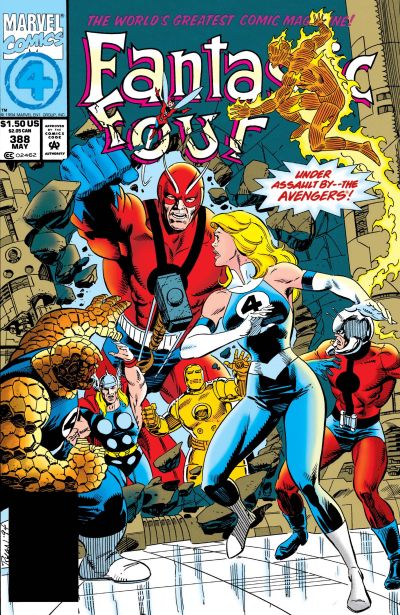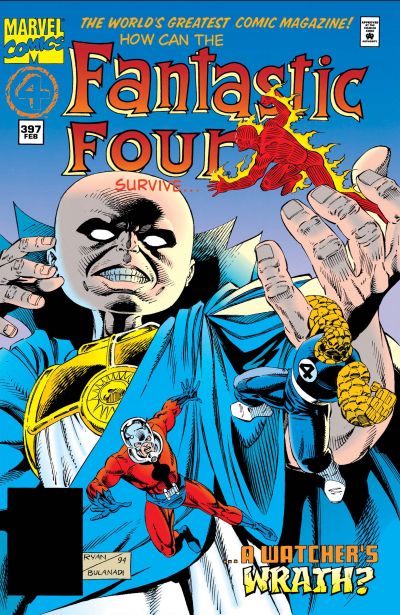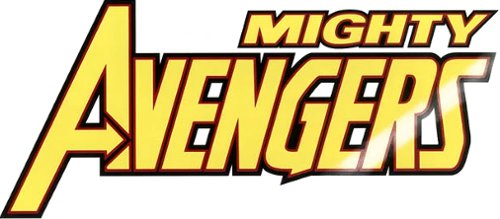Fantastic Four – (1994-1996)
Two years after taking over the Fantastic Four title with #356, writer Tom DeFalco decided to shake things up in a big way. At the end of a storyline involving Doctor Doom, DeFalco had the Latverian monarch incinerate himself… taking Mr. Fantastic alone with him. Even after they recovered from the shock, this left several obvious, gaping holes in the FF’s team. In terms of leadership, the Invisible Woman stepped up, filling the role for the next several years. Unfortunately, none of the remaining three members had the remotest expertise to fill in Reed’s scientific or technological responsibilities. In #384, the Invisible Woman introduced to the Torch and Thing their new electronics expert – Scott Lang. Recommended to her by none other than Tony Stark, it was hoped that Lang could fill in as a temporary technical advisor while they searched for Reed. Although everyone else was convinced that Reed was dead, Susan held out hope that her husband was out there somewhere, needing rescue.
One thing that Tony Stark had failed to mention, however, was that Scott Lang was also Ant-Man and when their HQ was invaded soon after by Psi-Lord (a very, very long story), the size-changing hero stepped in to help. Although it never seemed to be discussed directly, Lang’s Ant-Man began to accompany Sue, Ben and Johnny on their missions, aiding them during the Starblast crisis and  their journey through time looking for Reed. Unfortunately, these missions only exacerbated the tensions within the team, leading both the Torch and Invisible Woman to quit, leaving only the Thing as a member of the Fantastic Four. Even as the team disintegrated around him, Scott Lang fully intended to stick around… unless he got fired.
their journey through time looking for Reed. Unfortunately, these missions only exacerbated the tensions within the team, leading both the Torch and Invisible Woman to quit, leaving only the Thing as a member of the Fantastic Four. Even as the team disintegrated around him, Scott Lang fully intended to stick around… unless he got fired.
Despite their intentions to disband, the remaining Sue, Ben and Johnny kept reuniting for missions and Scott tagged along, helping in whatever way he could. Along the way, they ended up taking in Kristoff Vernard, the boy whom Doctor Doom had adopted and implanted his own personality. Although now free of Doom’s personality, Kristoff retained Doom’s intelligence and technical expertise. Partially to give himself something to do, in #403 Kristoff designed and built a new armored costume for Lang, one that would give him enhanced abilities above his ability to change sizes. It was soon after this that Cassie came to live with Lang at 4 Freedoms Plaza. Much to Lang’s dismay, Cassie and Kristoff seemed to hit it off.
The ongoing mystery of Reed Richard’s fate began to be answered in #405, leading to the team actually finding him marooned in time in #407. Traumatized by his imprisonment, Reed took a while to recover his wits and self-confidence. However, as he did so, Ant-Man stepped out of center stage. In fact, when the restored Fantastic Four went to confront Hyperstorm, the individual responsible for Reed’s imprisonment and most of their recent woes, Ant-Man stayed behind.  Despite him seeming superfluous, neither Reed nor anyone at the FF seemed to be eager to dismiss Lang from their employment. It is possible that he would have stayed much longer had DeFalco remained writer.
Despite him seeming superfluous, neither Reed nor anyone at the FF seemed to be eager to dismiss Lang from their employment. It is possible that he would have stayed much longer had DeFalco remained writer.
In 1996, Marvel had signed deals with Jim Lee & Rob Liefeld, two of the creators who had left Marvel a few years before to form image. The crux of the deal was that the two creators would take on four of Marvel titles (the Fantastic Four being one of them) and relaunch them as new series from the ground up. The resulting storyline was called Heroes Reborn. Before this could happen, though, the existing characters needed to be “written out” of the main Marvel Universe and the solution was to be found in the resolution of the Onslaught event going on among the X-titles. By the end of the Onslaught crossover, it appeared that both the Fantastic Four and the Avengers sacrificed their lives. Although Ant-Man was not among the number when they apparently died, he was in the final issue of Fantastic Four (1st series), which ended in September 1996 with #416 after thirty-five years of publication.
| Writers | Artists |
|---|---|
|
|
Fantastic Four Unlimited – (1994-1995)
In the mid-1990s, there were several series which had an “Unlimited” spin-off series. These supplementary titles were published quarterly with over twice the page count as a standard comic. Scott Lang’s Ant-Man appeared in the issues that were published in conjunction to his membership in the main title. All of these were stand-alone stories with little in the way of character development. Scott’s appearances in this title ran from Fantastic Four Unlimited #4 through #10, though in #4 he only appeared in a double spread “poster.”
| Writers | Artists |
|---|---|
|
|
Heroes for Hire (1st series) – (1997-1999)
With the departure of the Avengers and FF, it seemed Marvel wanted to experiment with other concepts. One of these was to reassemble Power Man and Iron Fist in a new series named Heroes for Hire. While this team's concept had been around since the late 1970s, it had only been featured in the series Power Man & Iron Fist and not its own title of that name. This Heroes for  Hire series would be the first such series but not the last, with a second 15-issue series running 2006-2007 and a third 12-issue series running troughout 2011.
Hire series would be the first such series but not the last, with a second 15-issue series running 2006-2007 and a third 12-issue series running troughout 2011.
While the first issue of this new series was plotted by Roger Stern, it was scripted by John Ostrander, who wrote the remaining of the nineteen issues. In the series, John Hammond, the original Human Torch and current CEO of Oracle, Inc., convinced Iron Fist to revive his Heroes for Hire business. The original two heroes also hired other heroes, one of whom turned out to be Ant-Man.
Despite the expanded concept, this was a time of glut at Marvel and the series did not catch on. In the context of the series, the true owner of Oracle Inc., Namor the Sub-Mariner, sold the company to Stark-Fujikawa, who in turn decided to make their own changes. Disapproving of ex-cons such as Scott Lang and Luke Cage on the team, the new management was about to dismiss them altogether. However, the rest of the team decided to quit in protest, ending Heroes for Hire’s short tenure.
| Writers | Artists |
|---|---|
|
|
Alias – (2002-2004)
Running parallel with his time with the Avengers (see below), Scott Lang set up on a blind date by Carol Danvers with Jessica Jones, former super-hero turned private detective. For a brief period of time the two dated, though his tenure on the title did not rise above a supporting character.
| Writers | Artists |
|---|---|
|
|
Avengers (3rd series) / Avengers (1st series) – (1999-2004)
When the Avengers returned following the Heroes Reborn story, Kurt Busiek took over the title, writing it for the series’ first 56 issues. During that time, Busiek tried to incorporate every character that had ever been an Avenger. Although he had never been one, he had Scott Lang respond to a summons from Captain America in #27 when he needed a secret, stealth team to assist with a mission. Despite his assistance, Lang was neither invited to join, nor asked to stick around. When Geoff Johns took over with #57, however, it seemed he had other plans.
John’s first story was called World Trust, in which an unknown but vastly powerful force was causing the world’s capital cities to vanish. When a call went out for assistance, Lang’s Ant-Man helmet, designed by Hank Pym, picked up the signal and he answered it. After the crisis was over, Hank Pym hinted to Lang that the Avengers could use another Ant-Man on the team. Despite initially turning him down, Lang ended up staying at the Avengers Mansion and accompanied the  teams on missions. During this time, Lang found himself at odds with Jack of Hearts, who considered him a “Pym-lite” Ant-Man. However, when Lang’s daughter Cassie had been kidnapped, Jack of Hearts not only stopped the assailant, but apparently died while doing so.
teams on missions. During this time, Lang found himself at odds with Jack of Hearts, who considered him a “Pym-lite” Ant-Man. However, when Lang’s daughter Cassie had been kidnapped, Jack of Hearts not only stopped the assailant, but apparently died while doing so.
Geoff Johns left the Avengers title with #76 and he was followed by a 9-issue run by Chuck Austen. It was the next writer, Brian Michael Bendis, who would change both the Avengers title, and the Scott Lang Ant-Man, for the next decade. Bendis took over the title with what would have otherwise been #85. However, as it coincided with what would have been Avengers (1st series) #500, it used that more impressive, prominent numbering. This new numerical status quo would not last long, however, as the title was to be canceled with #503, to make way for a new series, New Avengers – the first series to bear that name. These last four issues of the old title were meant to “clear the brush” and make room for the status quo Bendis wished to write about. Among these were the deaths of several Avengers, such as the Vision, Hawkeye and… Ant-Man.
In the context of the story, Jack of Hearts returned to the mansion and, appearing before Scott Lang, exploded, apparently killing him. In time, the rest of the Avengers would learn that this was due to the madness of the Scarlet Witch, which in turn would have ramifications throughout the titles of the Marvel Universe. For the moment, however, Scott Lang was now dead.
| Writers | Artists |
|---|---|
|
|
